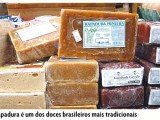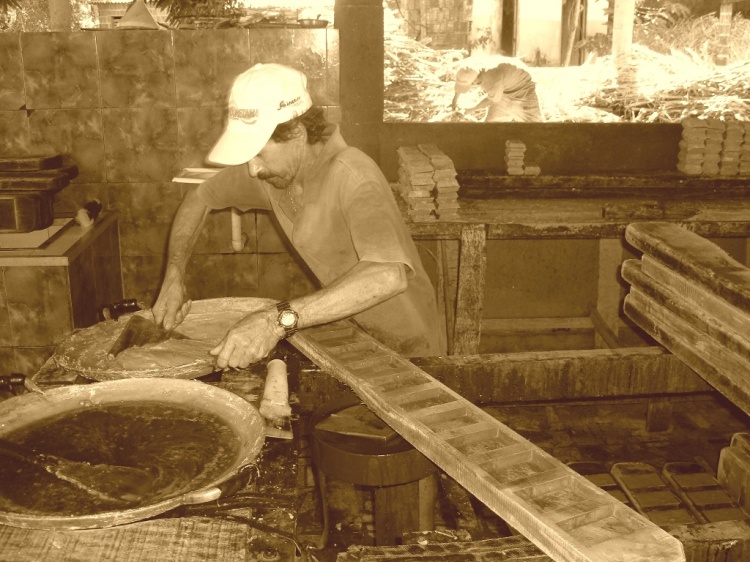Este post também está disponível em:
Português
English

The name rapadura, a variation of “raspadura” (from the verb raspar), originated from the scraping of the thick layers of sugar stuck to the walls of the pots used to make it.
It is typical of the north-east of Brazil. Its use is extensive and varies according to the cultural habits of each region that uses it.
In Brazil it is basically used as a substitute for sugar or for direct consumption, in chips, as a dessert.
In the Brazilian Northeast it was widely used by the sertanejo, along with flour, to be consumed at the workplace.
Ingredients such as cashew nuts, coconut and peanuts, among others, can also be added to rapadura.
Rapadura is a sweet of Azorean or Canarian origin in the form of small bricks, with a flavor and composition similar to brown sugar.
Made in small sugar mills, it emerged in the 16th century as a solution for transporting sugar in small quantities for individual use.
As granulated sugar moistened and melted easily, bricks of rapadura were easily accommodated in travelers’ bags, resisting atmospheric changes for months.
Rapadura is made from sugar cane after grinding, boiling the juice, molding and drying.
It is considered a food with greater nutritional value than refined sugar because, while the latter is almost exclusively sucrose, rapadura has other nutritional substances in its composition.
The name rapadura, a variation of “raspadura” (from the verb raspar), originated from the scraping of the thick layers of sugar stuck to the walls of the pans used to make it.
Regions of production of rapadura
It is typical of the Northeast of Brazil and several other regions of Latin America , where it receives different names such as: panela (Colombia, Venezuela, Mexico, Ecuador and Guatemala), piloncillo (Mexico), papelón (Venezuela and Colombia), chancaca (Bolivia and Peru), empanizao (Bolivia) or tapa de dulce (Costa Rica).

Produção da rapadura no nordeste
The name rapadura (or the variation raspadura) is also used in Argentina, Guatemala and Panama. Its use is also widespread in India.
In Latin America, Colombia is the first producer, with 1 million tons per year and the second in the world after India1 . The Northeast Region is the largest producer of rapadura in Brazil, where Ceará appears as the largest producer.
Process of making rapadura
After cutting the sugar cane, which must be done without burning it, it is transported to the mill where it must be ground.
The sugarcane juice resulting from the milling is taken to the decantation, in order to separate the impurities – at this stage the risk of fermentation of the juice can harm the appearance of the product.
The concentration until the point for beating is reached is done by boiling the juice, which can happen in the same pot or in up to five pots as in more modern mills, which helps to have a temperature control for the concentration of the juice.
After the broth becomes molasses it is beaten to obtain a greater consistency and be placed in forms in the traditional parallelepiped format. After the rapadura has hardened, cooled and taken its shape, it can be removed from the molds.
After beating, the concentrated broth is molded into 500 gram or one kilo molds or 20 to 25 gram tablets. After cooling, the rapadura is unmolded and finally packaged.
Consumption of rapadura
Its use is extensive and varies according to the cultural habits of each region that uses it. In Brazil it is basically used as a substitute for sugar or for direct consumption, in chips, as a dessert.
In the Brazilian Northeast it was widely used by the sertanejo, along with flour, to be consumed at the workplace.
To rapadura can also be added ingredients such as cashew nuts, coconut, peanuts, among others.
In other regions of Latin America it can be used as a medicine (citation needed), in the basic recipe of certain drinks or even sauces to accompany savory dishes.
Properties of rapadura
Rapadura is famous for its high caloric value, being also rich in vitamins, minerals and proteins.
The product is included in school meals in some states of the Northeast, such as Ceará, Paraíba and Pernambuco.
Bahia.ws – Tourism and Travel Guide of Salvador, bahia and Northeast Brazil



















